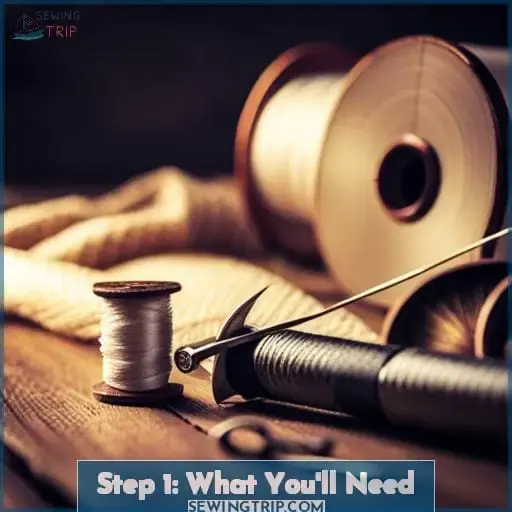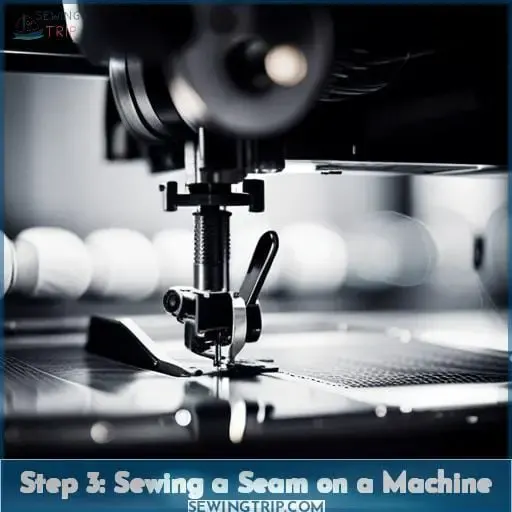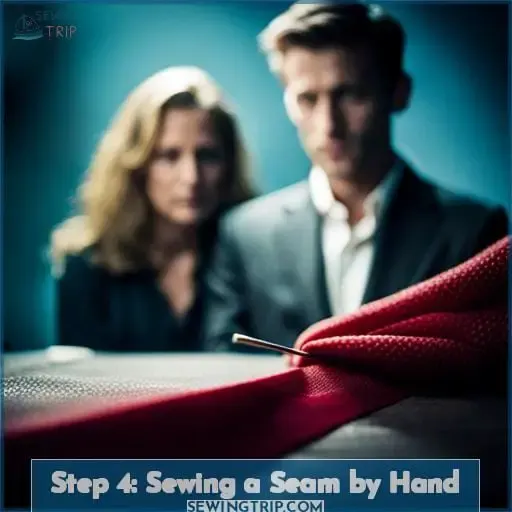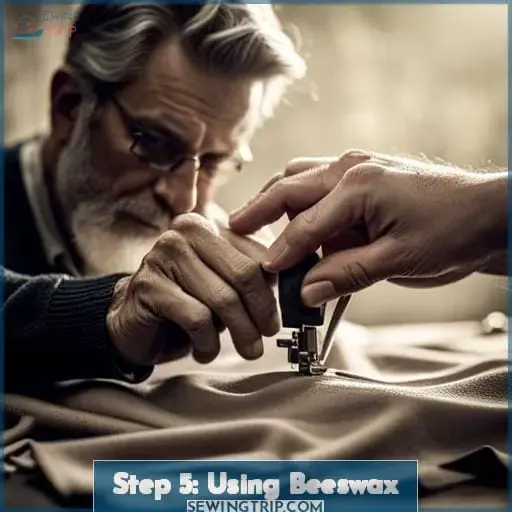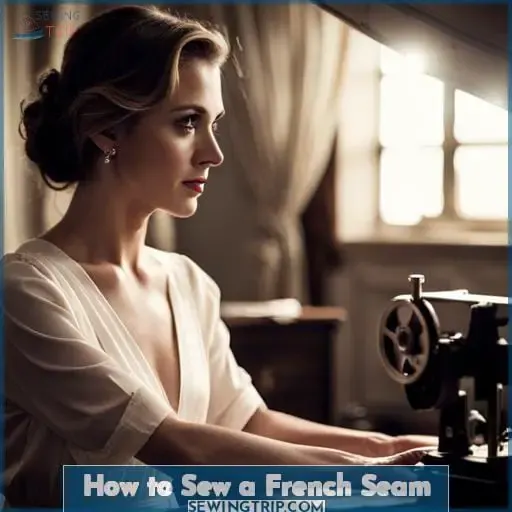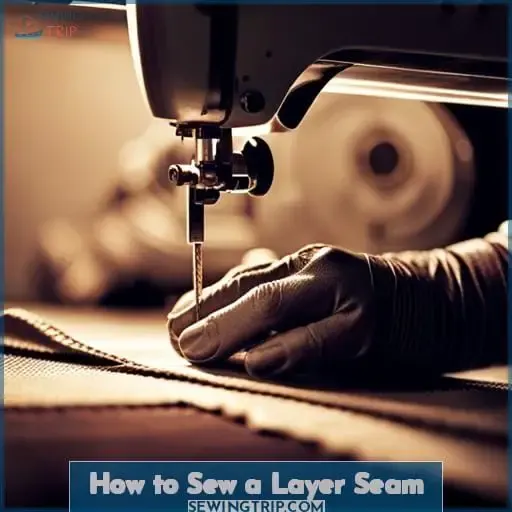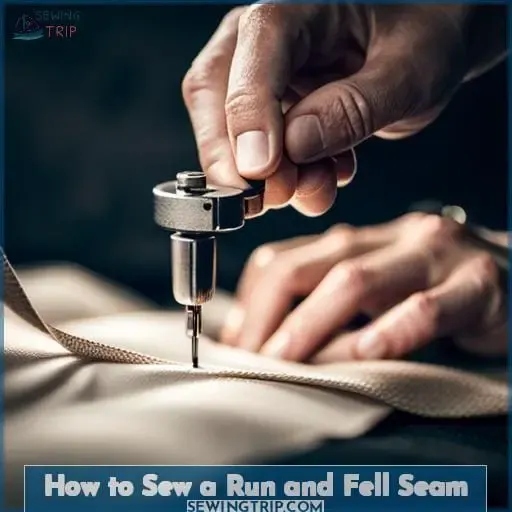This site is supported by our readers. We may earn a commission, at no cost to you, if you purchase through links.
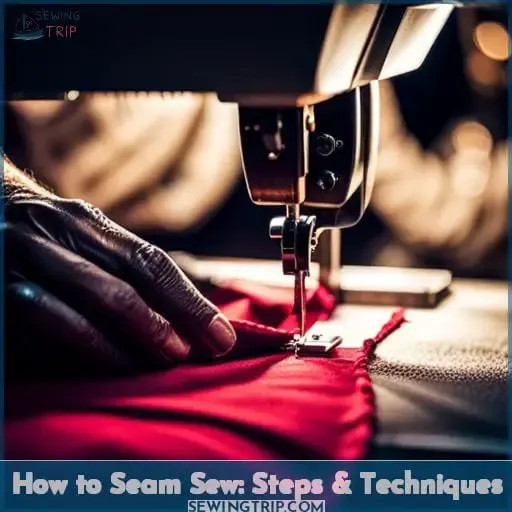 Ready to become a master of sewing seams? Look no further! In this article, you’ll discover the step-by-step techniques and insider tips for creating flawless seams every time.
Ready to become a master of sewing seams? Look no further! In this article, you’ll discover the step-by-step techniques and insider tips for creating flawless seams every time.
Whether you’re using a machine or stitching by hand, we’ve got you covered. From basic running stitches to advanced French seams, we’ll guide you through it all.
Get ready to unleash your sewing prowess and take your projects to new heights with our comprehensive guide on how to seam sew effectively!
Table Of Contents
Key Takeaways
- Essential materials for seam sewing include fabric, thread, needles, pins, and beeswax.
- Proper pinning techniques, such as vertical and horizontal pinning, ensure fabric alignment and prevent shifting during sewing.
- Machine seam sewing steps involve preparing the fabric, optional pinning, using a straight stitch with a 1/2-inch length, and pressing seams open with an iron.
- Hand sewing stitch options and finishing techniques, like running stitch, whip stitch, and backstitch, offer different choices for joining fabrics and preventing fraying.
Step 1: What You’ll Need
To begin seam sewing, gather essential materials:
- Fabric
- Thread
- Needles
- Pins
- Beeswax
Quality fabrics prevent fraying and provide durability.
Sharp needles pierce fabric cleanly.
Use all-purpose thread that matches fabric color.
Straight pins temporarily join fabric pieces.
Beeswax conditions thread, preventing tangles.
With quality tools in hand, focus shifts to technique:
- Straight stitches
- Precise seam allowances
- Backstitches securing seams
Master these fundamentals, then explore more complex seam styles.
Thoughtfully prepare materials and space before starting any sewing project.
This invests the required care into your craft.
Step 2: About Pinning
To properly secure your fabric pieces together before sewing, you’ll need to understand the proper technique of pinning.
Pinning is a crucial step in achieving clean and precise seams. When pinning, it’s important to consider the direction in which you insert the pins.
For vertical seams, such as side or center back seams, it’s recommended to pin vertically along the seam line. This helps keep your fabric layers aligned and prevents any shifting while sewing.
On the other hand, for horizontal seams like waistbands or hems, it’s best to pin horizontally across the seam line.
When inserting pins into your fabric pieces for stitching straight lines on a machine or hand-sewing stitches such as backstitching, ensure that you position them with their point tips facing towards you when using a machine so that they can be easily removed without disturbing your stitch work later on.
Properly securing each layer of fabric with pins not only ensures accurate alignment but also allows for smooth and effortless stitching without any puckering or distortion along the seam line.
Step 3: Sewing a Seam on a Machine
Now that you understand the importance of pinning, how do you sew a seam on a machine? Follow these steps to achieve beautifully stitched seams every time:
- Prepare your fabric:
- Make sure your fabric pieces are cut out and pressed open before sewing.
- Pinning the pieces together is optional but can help prevent mistakes.
- Sew your seam:
- Use a straight stitch and set your stitch length to 1/2 inch.
- Start stitching about 1/4 inch from the edge of the fabric and backstitch at the beginning and end of your seam for added security.
- Finish your seam:
- After sewing, press open the seams with an iron for a professional finish.
- You can also choose to clip or trim any excess fabric from the edges using pinking shears or zigzag stitching to prevent fraying.
Remember to take it slow, sew carefully, and experiment with different techniques like backstitching or using a zigzag stitch depending on what works best for each project’s needs!
Step 4: Sewing a Seam by Hand
When sewing by hand, you have three options for your stitches:
- Running stitch
- Whip stitch
- Backstitch.
The running stitch is quick to work, but less sturdy.
The whip stitch helps keep edges from fraying, but is difficult to keep tension correct.
The backstitch creates the strongest seams, but requires more thread.
Running Stitch
After sewing a seam on a machine, you can finish the seam by hand with a running stitch. This quick and easy stitch is perfect for joining two pieces of fabric together.
Whip Stitch
The whip stitch helps keep edges from fraying, but it can be difficult to keep tension correct.
To sew a whip stitch, poke your needle through the marked line from the bottom of your fabric, then poke it up through the fabric about 1/8″ away.
Repeat this process, making sure to keep your stitches close together.
Backstitch
After the whip stitch, the backstitch is the next strongest hand sewing stitch.
It creates a strong, durable seam that’s perfect for garments and home décor projects.
Step 5: Using Beeswax
Beeswax is great for keeping your thread from tangling.
Simply drag the thread along the top of the chunk of beeswax, coating it well.
Rub the thread between your fingers to help warm up the wax.
Step 6: Comparing the Seams + Extras
After sewing your seam, you have 3 options for finishing the raw edge:
- Serged seam
- Zigzag or faux-overlocked seam
- Pinked seam
Learn the pros and cons of each so you can choose the best one for your project.
Serged Seam
After using beeswax, serged seams are often used in ready-to-wear clothing as they’re created with a special machine called a serger.
The serger stitches the seam and cuts off the excess fabric at the same time.
Zigzag or Faux-overlocked Seam
If you don’t have a serger, try zigzag stitching over the raw edges of your seam allowance.
This technique is perfect for finishing seams on knits, stretch fabrics, and even wool.
Adjust the zigzag stitch width and length to achieve the desired look and functionality.
With this method, you can create an enclosed seam that prevents fraying while adding strength to your garment construction.
Mastering different seam finishes like this will elevate your sewing skills to new heights of perfection and professionalism!
Pinked Seam
To create a finished edge that prevents fraying, consider using a pinked seam. Pinked seams are popular in sewing for their functionality and decorative appeal.
Here are some key points to know about pinked seams:
- Pinked seam uses include finishing edges on cotton and sturdy fabrics.
- Pros of pinked seams include preventing fraying and adding visual interest.
- Cons of pinked seams include limited durability compared to other finishing techniques.
- Pinked seam tutorials can be found online or in sewing books for step-by-step instructions.
-Pinking shears or rotary cutters with pinking blades are essential tools for creating a clean zigzag pattern on the fabric edges.
How to Sew a French Seam
Sew a French seam by folding the fabric and stitching it twice for a clean, enclosed finish. This technique is perfect for delicate fabrics or when you want to achieve a polished look on the inside of your garment.
Here are three reasons why you should consider using a French seam:
- Superior durability: A French seam provides extra strength as it involves sewing two lines of stitches, ensuring that the fabric edges are securely enclosed within the seam.
- Neat and professional appearance: With all raw edges hidden away, your finished project will have an impeccable and refined look both inside and out.
- Versatility with different fabrics: While commonly used in lightweight materials such as chiffon or silk, French seams can also be adapted for knit fabrics or even leather with slight modifications to stitch length and tension settings.
By mastering this skillful technique, you’ll elevate your sewing repertoire while achieving beautifully finished garments every time!
How to Sew a Layer Seam
Now let’s move on to layering your fabric and sewing a seam together. Sewing a layer seam is an essential skill for creating sturdy and professional-looking garments.
- Prepare your fabric layers:
- Ensure that the raw edges of both pieces of fabric align perfectly, with the right sides facing each other.
- Pin them together at regular intervals along the seam line.
- Sew with precision:
- Using a matching thread color, sew along the designated seam allowance using either a straight stitch or zigzag stitch on your sewing machine, ensuring that you backstitch at both ends for added strength.
- Finish and press:
- After sewing, trim any excess threads or loose fibers from your finished seams before pressing them open with an iron set to medium heat.
By following these steps carefully, you’ll be able to achieve clean and durable layer seams in no time!
How to Sew a Run and Fell Seam
Start by folding the raw edge of one fabric piece over the other, creating a 1/4 inch (0.
A run and fell seam is a strong and durable stitching technique that’s commonly used in heavy-duty fabrics or garments that require extra reinforcement.
- Fabric Weight: Run and fell seams work best with medium to heavyweight fabrics as they provide added strength to withstand wear and tear.
- Seam Allowances: When sewing a run and fell seam, it’s important to account for wider seam allowances since this technique involves folding an additional layer of fabric over the initial folded edge.
- Pressing Techniques: To achieve neat results, press your sewn seam open before proceeding with folding the excess fabric over.
Frequently Asked Questions (FAQs)
Can I use regular thread instead of beeswax for hand sewing?
Yes, regular thread can be used for hand sewing instead of beeswax. However, using beeswax provides added benefits such as:
- Preventing tangling
- Strengthening the thread
It’s a choice that depends on your preference and desired outcome.
What is the purpose of backstitching at the beginning and end of a machine-sewn seam?
Backstitching at the beginning and end of a machine-sewn seam is crucial for securing the stitches and preventing unraveling. It adds strength to your seams, ensuring durability and longevity in your sewing projects.
How do I prevent my fabric from fraying after sewing a seam?
To prevent fraying after sewing a seam, apply finishing stitches like:
- Serged seams
- Zigzag stitching
- Pinked seams
These techniques reinforce the raw edge of fabric and keep it from unraveling, ensuring your creations stand the test of time.
Can I use a regular sewing needle instead of a specific hand sewing needle?
Yes, you can use a regular sewing needle for hand sewing, but using a specific hand sewing needle is recommended.
It’s designed to handle the demands of stitching fabric and will ensure better results.
What is the recommended seam allowance for sewing a basic seam?
For a basic seam, the recommended seam allowance is 1/2 inch.
This allows for easy construction and provides stability to your garment.
With this knowledge, you can confidently sew your way to mastery and create beautiful pieces with precision.
Conclusion
To become a master of seam sewing, follow our step-by-step guide on how to seam sew effectively.
Whether you’re using a machine or stitching by hand, we’ve got you covered with techniques like the running stitch, whip stitch, and backstitch.
Don’t forget the importance of pinning and using beeswax for smooth seams.
Explore different seam options like serged, zigzag, and pinked seams to add a professional touch to your projects.
And for more advanced techniques, learn how to sew French, layer, and run and fell seams.
Get ready to unleash your sewing prowess and create flawless seams every time!

